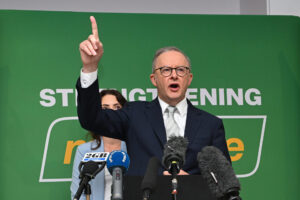The talk about domestic and family violence prevention is big, the funding less so
The amount committed by both political parties to preventing domestic and family violence suggests they believe there are other, more important, priorities.
Election campaigns are when political parties tell us their priorities – they will structure their campaigns around certain themes, all designed to show voters that they are listening and they care.
But these priorities are often limited by notional and often arbitrary lines about what can be afforded to be done. Before the Budget this year, for example, the Finance Minister Katy Gallagher said: “as Finance Minister, I probably get a hundred good ideas for one that we can do.”
Because election commitments are accompanied by costings, voters can get a real sense of what political parties truly think are their priorities – and how much they are willing to spend when something is for them a priority.
Across the community, there is serious concern about the prevention of domestic and family violence. Until today, it hasn’t really featured in the campaign. So far in the campaign, Labor have promised $8.6 million in additional spending to tackle domestic and family violence. While today the Liberal Party has just announced a $90 million policy.
How much is that money? Surely it is sizeable given for example Peter Dutton said this morning that “most every measure in this space is supported on bipartisan basis because everyone accepts the fact that the scourge of violence and domestic violence, financial coercion and every aspect in this debate is completely and widly unacceptable in our society and we should do everything together to try to defeat it and work toward a better outcome for individuals and for our country as well.”
Surely, if it is bipartisan and a scourge (which it most certainly is), there would be no real limit to the amount that could be spent?
And yet, while this election has seen ‘security’ on the agenda, from announcements of big new defence spending to the ongoing non-story about an Indonesian airbase, both major parties have failed to recognise that ‘security’ should mean “keeping Australians safe”.
Importantly, this should include efforts to end one of the largest threats to the safety of Australians: domestic and family violence. Domestic and family violence is a serious and ongoing threat to the security and safety of Australians. On average, one woman was killed every ten days by a current or former partner in 2024.
Unfortunately for Australia’s political mainstream, security more often means ensuring Australia has the newest and fanciest submarines, aircraft and other weapons. The priorities of both major parties can be seen by looking at their announced election commitments. The Coalition has just announced a $90 million domestic violence strategy, which is less than a fiftieth (1.5%) of its $6 billion one-off cut to fuel excise and less than half a per cent (0.4%) of its $21 billion promised increase to defence spending.
Election commitments reflect the concerns of political parties. The amount spent on domestic and family violence prevention, however, suggests that both parties are spending just enough to make it seem like they care, but nowhere near as much as for things that they truly believe are priorities.
Between the Lines Newsletter
The biggest stories and the best analysis from the team at the Australia Institute, delivered to your inbox every fortnight.
You might also like
One more time? | Between the Lines
The Wrap with Amy Remeikis If the polls, the trend, and the vibe are all right, then voters are about to give the Albanese government another chance. But you can feel the reluctance. The only question that seems to remain is whether Labor will govern in its own right, or as a majority. From the
Failing the test: Australian universities in crisis
Great countries have great institutions, but Australian universities are a mess.
Home economics: housing, living standards and the federal election
With housing affordability at an all-time low and the spectre of Trump looming large over our region, Australians’ standard of living will be at the heart of the debate from now until election day.



